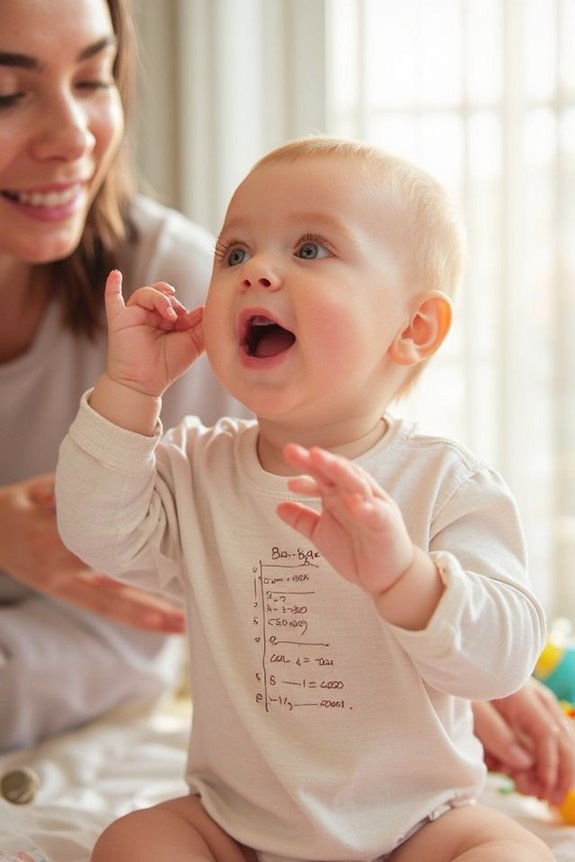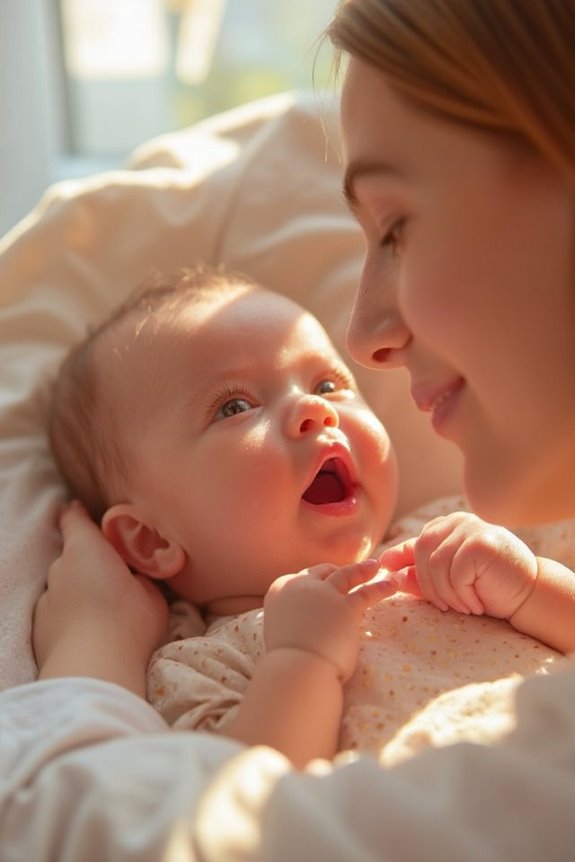Babies are born seeing only black, white, and gray. Their color vision develops gradually over their first year. At 2-3 months, infants begin recognizing red and green, followed by blue around 3 months. By 4 months, yellow enters their visual spectrum. Most babies develop full color perception by 5-6 months, though it’s less vivid than adult vision. High-contrast toys and colorful environments support this development. The following information explains how you can help stimulate your baby’s emerging color perception.
Key Takeaways
- Newborns primarily see in black, white, and gray shades until their color vision gradually develops.
- Babies begin distinguishing red and green colors at around 2-3 months of age.
- Blue perception emerges at approximately 3 months, followed by yellow at 4 months.
- By 5-6 months, infants develop full color spectrum vision, though less vivid than adults.
- Color vision continues improving, with color constancy under different lighting emerging by 10-12 months.
Newborn Vision: From Black and White to Color
When your baby first opens their eyes to the world, they’re not seeing the colorful environment you do. Instead, newborns primarily see in black, white, and shades of gray. Their developing visual system responds best to high visual contrasts rather than colors.
During the first weeks of life:
- Babies are highly sensitive to light and dark patterns
- Bold stripes and checkerboards are most easily detected
- Color sensitivity begins to emerge gradually after a few weeks
- Red tones may be the first colors occasionally distinguished
This limited vision is normal and expected—your baby’s retina and visual cortex are still maturing. The neural pathways necessary for processing color information strengthen over time through experience and exposure to their environment.
The Timeline of Color Perception Development
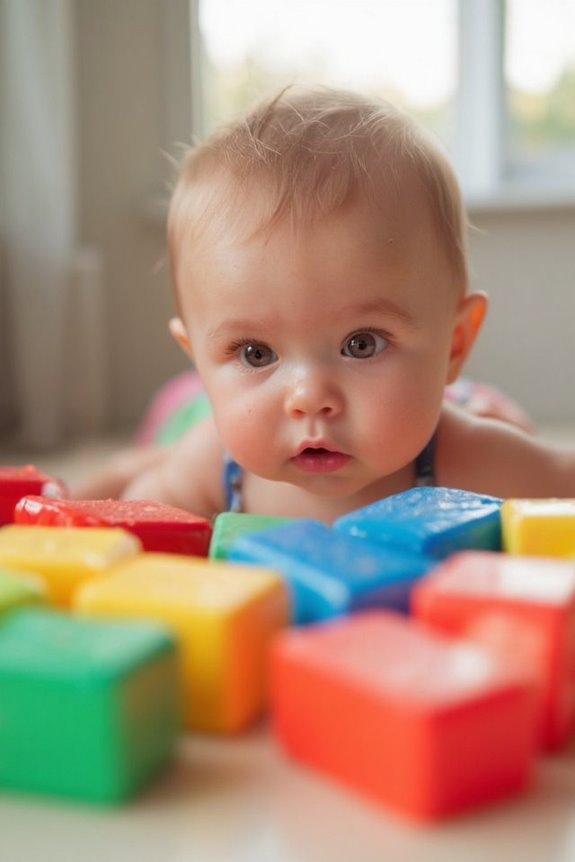
Your baby’s journey into the colorful world unfolds in several distinct stages over their first months of life. The progression of color perception follows a predictable pattern:
- 2-3 months: Red and green hues become distinguishable as the first colors babies recognize
- Around 3 months: Blue tones emerge in your baby’s visual spectrum, though typically less distinct than reds
- 4 months: Yellow and additional colors begin appearing, enhancing visual development
- 5-6 months: Full color spectrum vision develops, though less vivid than adult perception
During this critical period, your baby’s cone cells and neural pathways are rapidly maturing. High-contrast toys and colorful environments greatly support this development. As color perception improves, you’ll notice increased curiosity and engagement with surroundings as your little one explores their increasingly vibrant world.
Key Milestones in Infant Color Recognition

Five distinct stages mark your baby’s journey into a world of color, each representing essential developmental progress in their visual system. Understanding these milestones helps you track their development:
- 2 Months: Initial color detection begins, with babies responding to high-contrast colors (red, yellow, blue)
- 4 Months: Vision expands to include blue and yellow with greater clarity
- 5-6 Months: Full color spectrum perception develops, approaching adult-like vision
- 7 Months: Differentiation between varied color shades improves as cognitive connection strengthens
- 10-12 Months: Color constancy emerges, allowing babies to recognize colors under different lighting conditions
These developments depend on brain maturation, eye development, and environmental stimuli. While most babies follow this timeline, individual development may vary slightly.
How Melanin Shapes Eye Color Evolution
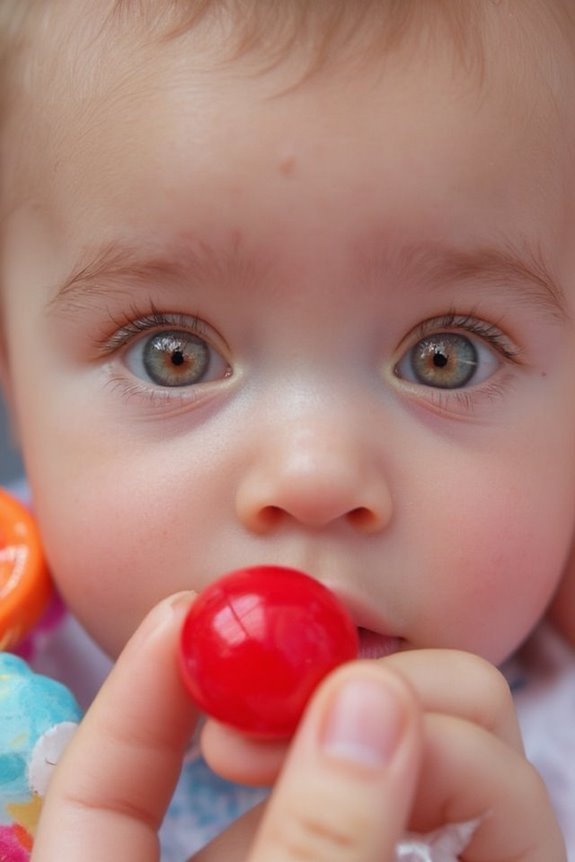
Melanin, the pigment responsible for coloring our skin, hair, and eyes, plays a fundamental role in determining eye color through complex genetic mechanisms. The fascinating story of eye color evolution begins with melanin genetics.
About 16 different genes influence eye color, with OCA2 and HERC2 being the key players. These genes control melanin production in the iris:
- Higher melanin levels create brown eyes (most common worldwide)
- Lower levels result in blue eyes (originated ~50,000 years ago)
The OCA2 mutation that produces blue eyes can be traced to a single common ancestor from the Black Sea region. As humans migrated from Africa, environmental adaptations likely influenced color evolution, creating the diverse spectrum of eye colors we see today.
Stimulating Your Baby’s Developing Color Vision
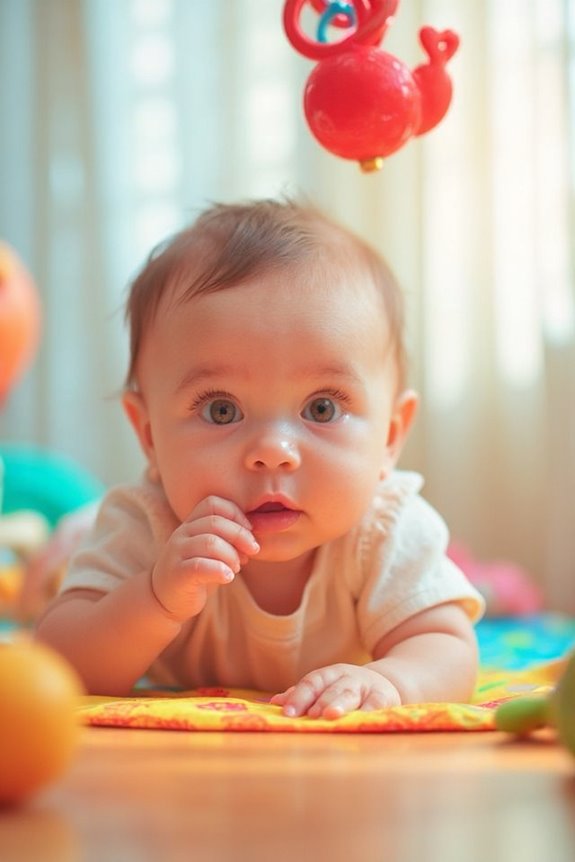
While melanin determines our eye color, babies’ ability to see color develops gradually over their first few months of life. I recommend using this developmental window to enhance their visual skills.
Creating an environment rich in visual stimulation is key to supporting your baby’s color vision development:
- Place high-contrast black and white patterns near your newborn
- Introduce red and green colorful toys between 2-4 months
- Facilitate natural lighting when possible for ideal color perception
- Engage in interactive play with brightly colored objects
- Use mobiles and colorful books as visual stimulation tools
You’ll notice your baby’s increasing interest in colors as their vision matures. By six months, they’ll typically see the full spectrum of colors, similar to adult vision. Regular pediatric check-ups can confirm this development is on track.
The Science Behind Visual Neural Pathway Formation
As your baby grows, complex neural networks are forming in their brain that will eventually allow them to see the full spectrum of colors. This remarkable process begins in the retina and extends to the visual cortex.
The development follows a specific timeline:
- Newborns see primarily in black, white, and gray
- At 2-3 months, red and green cone cells mature first
- By 6 months, most babies develop blue cone cells and full color vision
Brain plasticity plays a vital role in this development, allowing neural pathways to strengthen in response to sensory input from the environment. The integration of color signals occurs through specialized processing that matures surprisingly early—research shows that by five months, babies can already process moving colored objects similar to adults.
Frequently Asked Questions
Can Color Blindness Be Detected in Infants?
Yes, I can detect color blindness in infants after 3-4 months using specialized preferential looking tests. Since color perception develops gradually, severe deficiencies linked to genetic factors become apparent as their visual system matures.
Do Premature Babies Develop Color Vision on the Same Timeline?
Like a late-blooming flower, premature babies may need extra time. I’ve found they often develop color perception later than full-term infants when considering their gestational age. Premature vision typically follows the same sequence, just adjusted.
Can Babies See Colors Better in Natural or Artificial Light?
Natural light is best for your baby’s color vision. While they can see colors in artificial light too, I’ve found that natural lighting enhances color visibility and supports their developing visual system more effectively.
Does Breastfeeding Versus Formula Affect Color Vision Development?
I’m not fully convinced there’s a direct link between baby’s nourishment choices and color vision development. While breastfeeding benefits are numerous, formula differences haven’t been specifically connected to how infants develop their color perception abilities.
Can Illness or Medication Affect a Baby’s Developing Color Vision?
Yes, I’ve found that illness and medication can affect a baby’s color perception. Certain medications impact the retina, while illnesses might delay visual development. That’s why regular vision checks are important during treatment.


